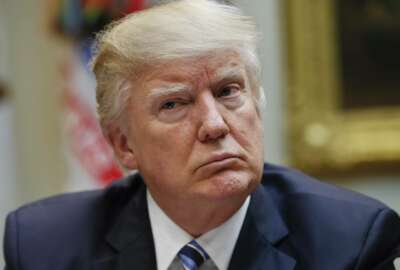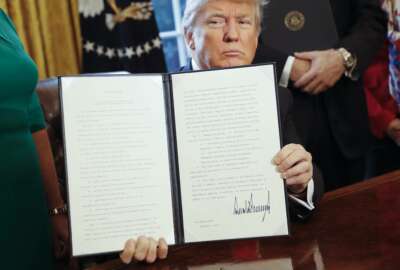

Hubbard Radio Washington DC, LLC. All rights reserved. This website is not intended for users located within the European Economic Area.
Office of Management and Budget Director Mick Mulvaney sent a memo to agency leaders outlining a series of long and short term actions agencies need to take aro...
This story has been updated at 11 p.m. on April 11.
The White House’s plan for reforming government and reducing the federal workforce is one of the most ambitious undertakings over the last 20 years.
The 14-page memo issued to agency leaders by Office of Management and Budget Director Mick Mulvaney on April 12 outlines a series of long- and short-term actions agencies need to take around reducing the number of employees, improving how they measure employee performance and restructure their mission areas.
“The government hiring freeze will end with the release of this guidance. That doesn’t mean, and I made it very clear to all of the agency heads and the deputy chiefs over the last couple of days, the agencies will be free to hire willy-nilly. What we are doing is replacing the across-board hiring freeze that we put in place day one, and replacing it with a smarter plan, a more strategic plan, a more surgical plan,” Mulvaney said during a press briefing April 11. “To the larger issue, the government reorg is probably the biggest story no one is talking about. Yes, we talk about health care. Yes, we talk about taxes. And yes we talk about infrastructure. All of those are extraordinary critical to rebuilding the country. This is something that goes much deeper and to the very structure of government. This is trying to do something that never has been done before. The executive branch of government has never been rebuilt. It has grown organically over the course of the last 240 years. The President of the United State has asked all of us in the executive branch to start from scratch. A literal blank piece of paper, and say, ‘If you were going to rebuild the executive branch, what would it look like?’”
Mulvaney said in the end, the goal of this two-year effort will be to make the government “dramatically more accountable, more efficient and more effective.”
This memo is the implementation guidance required under President Donald Trump’s executive order in March to reorganize the government.
In that order, OMB gave agencies 180 days to submit a reorganization strategy and this memo details how agencies should go about that.
Robert Shea, a former OMB executive under the President George W. Bush administration and now a principal with Grant Thornton, said one of the few comparable efforts around reorganization came with the creation of the Homeland Security Department in 2002.
“In that case, we were trying to move and integrate all or part of 22 different federal departments and agencies. Here, we’re talking, well, about all of them. So, it’s like creating the Department of Homeland Security times 25, at least,” he said. “If they try to do that, they’ll fail. If they break it into manageable parts, it might not just be the most ambitious reorganization in the last 20 years or more, it could also be the most successful.”
Additionally, the new memo meets the goal in the hiring freeze policy issued on the president’s first day in office.
In that memo, OMB said it and the Office of Personnel Management would take 90 days to develop a long-term plan for reducing the size of the federal workforce through attrition.
While some agencies have garnered exemptions for certain positions from the freeze, most positions have been affected.
Mulvaney said at the briefing that the workforce reduction initiative will follow the basic outline of the initial fiscal 2018 budget, where some agencies, such as the Defense Department and the Veterans Affairs Department, saw increased spending requests and therefore would expect to see increases in their workforces. Meanwhile, other agencies, such as the Environmental Protection Agency, which saw their budgets reduced in the request, would face workforce reductions as well.
“There will be some places where they have the ability to reduce size immediately and they may be called upon to do that in order to line up with the president’s priorities. There may be other places where they don’t have that flexibility and they will have to figure out a way over the course of time through ordinary attrition to get to where they need to be,” Mulvaney said. “I can tell you this is a big part of draining the swamp. We focus on things like getting lobbyists out of the process and the five-year ban, and that’s certainly part of draining the swamp. But really what you are talking about doing is restructuring Washington, D.C. That is how you drain the swamp.”
Mulvaney said he’s unsure what the total number of federal employees should be, but he believes the Trump administration could run the government more efficiently and with fewer people than the previous administration.
To get to that smaller workforce, agencies must begin taking steps immediately and submit a plan to OMB by September as part of their fiscal 2019 budget submission.
“OMB directs agencies to identify workforce reductions over a four-year (2018 through 2022) consistent with discretionary out year levels included in the fiscal 2018 budget this spring and forthcoming OMB guidance on fiscal 2019 budget submissions,” the memo stated. “Agencies should begin planning for these reductions now, as achieving associated personnel reductions takes time to implement and realize savings.”
Over the short term, OMB said OPM will provide agencies with streamlined templates to request approval for early retirement authority. The memo says OPM will provide expedited reviews for most requests within 30 days.
OMB says among the first steps agencies can take is reviewing vacant positions and determining if they are necessary any longer.
OMB says agencies should consider for all positions that become vacant:
Additionally, OMB wants agencies to review all employees currently on administrative leave and determine if those individuals should return to work and assigned alternative duties, or face disciplinary actions including removal.
Over the longer term, OMB directed agencies to review several other areas as they develop their plans, including data to determine appropriation staffing levels based on what it takes to meet the mission requirements today instead of previous budget allocation levels.
“Agencies need to examine the total cost of their personnel and not only the number of employees. Staffing levels may not present the full picture of whether an agency’s workforce is optimally structured,” OMB stated. “For example, there are situations where it may be more efficient to restructure duties to enable additional lower-graded employees to do lower-level work previously assigned to higher-graded positions, and consolidate the higher-graded work into fewer positions. Employee-related costs include not only total salary and benefits, overtime, training, awards, career ladder progression, but also employee services and office expenses.”
Agencies also should keep a few other dates in mind.
By June 30, departments must submit a plan to OMB on how they will maximize employee performance. These plans should focus on reviewing and updating agency policy around limiting the use of paid administrative leave and using performance improvement plans to address poor performing employees.
OMB directed agencies to create a Manager Support Board comprised of internal experts on employee-labor relations to help managers agency-wide address performance and conduct issues.
Also by June 30, OMB will meet with agencies to review their high-level draft of their agency reform plans. In July, OMB will meet with CFO Act agencies and a limited number of others to provide feedback and identify actions that could be taken immediately.
Final reform plans are due to OMB by September as part of the 2019 budget proposal.
OMB says starting in February 2018 it will begin tracking progress on the governmentwide reform plan.
Mulvaney said he will submit a final plan to Trump for agency restructuring and reorganization by March 2018.
“We are not going into this with some ideological preconception about what this will look like. This is a really blank sheet of paper. We are not just asking conservative right-wing think tanks to give us ideas on how to fix this. We are asking the general public, intellectuals, academia and the private sector to give us ideas. It may well be that they come in and make a very good case for the exact opposite of what might be the pre-conceived notion of a former right-wing member of Congress.”
Copyright © 2024 Federal News Network. All rights reserved. This website is not intended for users located within the European Economic Area.
Jason Miller is executive editor of Federal News Network and directs news coverage on the people, policy and programs of the federal government.
Follow @jmillerWFED


